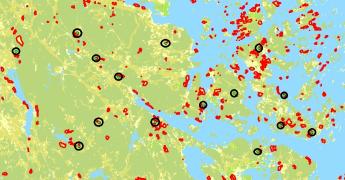
Sampling strategy
In the county of Östergötland, we used a strategic sampling strategy to increase probability of catching beetles, i.e. the best sites known were used. The selection process was divided into two steps described below.
Map selection
The first step was to choose areas with the right basic habitat conditions for the beetle. A digital map over woodland key biotopes and their associated attribute table was used to separate rocky outcrops, where Scots pine usually is the dominant tree species, from other areas. The category “rocky outcrops” contained some information about how the area looked like, such as “rich in dead wood”, and this information was used to distinguish the potentially more valuable areas from all other “rocky outcrop” areas.
Field selection
The second step was to judge, in the field, whether or not the rocky outcrop areas were at least somewhat suitable for T. depsarium. One reason for the second selection in the field was because the descriptions of the areas were not well updated. Another reason was to find out if it was possible to reach the location within a reasonable time from the nearest place where the car could be parked, i.e. if the road was okay or blocked too far from the trap location.
Östergötland data set
The data set from Östergötland County consisted of 100 traps scattered over the landscape. The majority of the sites were situated 2.5 km away or more from the nearest neighbouring trap, and that distance was also used as a guideline when selecting trap locations. This specific distance was primarily set to avoid overlapping of landscape variables between different sites, but also since it was thought to be enough to prevent most of the inference between activated traps. However, due to a lack of suitable areas at the guideline distance, some traps were located between 1.9 and 2.5 km away from each other.
In each area, within a 30 m radius from the trap, three variables were measured; 1) The number of pine logs (fallen trees only) exceeding 25 cm at 1.3 m from the root end 2) the number of pine logs with presumed exit holes from T. depsarium 3) the average crown cover.
Responsible for this page:
Director of undergraduate studies Biology
Last updated:
05/11/15
